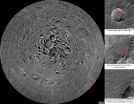(Press-News.org) Men who as children had glomerular disease, a disorder of the portion of the kidney that filters blood and one that usually resolves with time, were more likely than men without childhood glomerular disease to have high blood pressure as an adult, according to a study in the March 19 issue of JAMA.
Glomerular disease was defined for this study as glomerulonephritis or nephrotic syndrome (both are kidney disorders). Most children who develop glomerular disease have a favorable prognosis with complete resolution of all signs and symptoms. Yet the long-term complications of resolved childhood glomerular disease are incompletely understood, according to background information in the article.
Asaf Vivante, M.D., of IDF Medical Corps, Tel-Hashomer, Israel, and colleagues conducted a study that included male military personnel in Israel, who had a baseline evaluation conducted prior to recruitment at age 17 years, during which the diagnosis of resolved childhood glomerular disease was determined. Participants were followed up until the diagnosis of hypertension (systolic >140 mm Hg or diastolic >90 mm Hg), retirement from service, or December 31, 2010, whichever came first.
The study included 38,144 career personnel, of whom 264 were diagnosed with a medical history of resolved childhood glomerular disease. During an average follow-up of 18 years, 2,856 participants developed hypertension; 13.6 percent of participants with a medical history of resolved childhood glomerular disease and 7.4 percent of those without such history.
"In this study, resolved childhood glomerular disease was associated with subsequent risk of hypertension in a cohort of young healthy adult men," the authors write. They add that their results suggest that glomerular disease during childhood may initiate kidney injury that manifests in adulthood, well before sufficient loss of excretory kidney function can be measured with standard laboratory tests, such that the first manifestation may be adult hypertension.
INFORMATION:
(doi:10.1001/jama.2013.284310; Available pre-embargo to the media at http://media.jamanetwork.com)
Editor's Note: Please see the article for additional information, including other authors, author contributions and affiliations, financial disclosures, funding and support, etc.
Children with glomerular kidney disease more likely to have hypertension as adults
2014-03-18
ELSE PRESS RELEASES FROM THIS DATE:
Study finds no evidence that vitamin D supplements reduce depression
2014-03-18
NEW YORK, NY (March 18, 2014) — Vitamin D deficiency has been implicated in numerous health conditions in recent years, including depressed mood and major depressive disorder. Recent observational studies provide some support for an association of vitamin D levels with depression, but the data do not indicate whether vitamin D deficiency causes depression or vice versa. These studies also do not examine whether vitamin D supplementation improves depression.
A systematic review of clinical trials that have examined the effect of vitamin D supplementation on depression ...
JCI online ahead of print table of contents for March 18, 2014
2014-03-18
Cardiac conduction altered by intragenic enhancer
Genome-wide association studies (GWAS) have determined a surprising link between dysfunctional cardiac conduction and variants within SCN10A, which encodes nociceptor-associated sodium-gated ion channel subunit NaV1.8. Follow-up functional studies targeting NaV1.8 revealed only a minor contribution to cardiac physiology; therefore, it was unclear how SCN10A mutations promoted the development of cardiac conduction disease. In this issue of the Journal of Clinical Investigation, the research groups of Vincent Christoffels, ...
New from Geology: Fossils, earthquakes, gold, and sea-bed landslides
2014-03-18
Boulder, Colo., USA – Geology papers published 17 Mar. 2014 cover (1) modeling of seabed turbidity currents; (2) a large earthquake at Lake Vättern, Switzerland, about 11,500 years ago; (3) genesis of high-grade gold at the Porgera gold deposit, Papua New Guinea; (4) discovery of the Ediacaran guide fossil Cloudina sp. and the depositional age of the Bambuí Group; (5) earthquakes along the fossil Moho in Alpine Corsica; and (6) using LiDAR to better understand New Zealand's Alpine Fault.
Highlights are provided below. Geology articles published ahead of print can be accessed ...
NASA releases first interactive mosaic of lunar north pole
2014-03-18
Scientists, using cameras aboard NASA's Lunar Reconnaissance Orbiter (LRO), have created the largest high resolution mosaic of our moon's north polar region. The six-and-a-half feet (two-meters)-per-pixel images cover an area equal to more than one-quarter of the United States.
Web viewers can zoom in and out, and pan around an area. Constructed from 10,581 pictures, the mosaic provides enough detail to see textures and subtle shading of the lunar terrain. Consistent lighting throughout the images makes it easy to compare different regions.
"This unique image is a tremendous ...
Fierce 2012 magnetic storm barely missed Earth
2014-03-18
Earth dodged a huge magnetic bullet from the sun on July 23, 2012.
According to University of California, Berkeley, and Chinese researchers, a rapid succession of coronal mass ejections – the most intense eruptions on the sun – sent a pulse of magnetized plasma barreling into space and through Earth's orbit. Had the eruption come nine days earlier, it would have hit Earth, potentially wreaking havoc with the electrical grid, disabling satellites and GPS, and disrupting our increasingly electronic lives.
The solar bursts would have enveloped Earth in magnetic fireworks ...
New statistical models could lead to better predictions of ocean patterns
2014-03-18
COLUMBIA, Mo. – The world's oceans cover more than 72 percent of the earth's surface, impact a major part of the carbon cycle, and contribute to variability in global climate and weather patterns. However, accurately predicting the condition of the ocean is limited by current methods. Now, researchers at the University of Missouri have applied complex statistical models to increase the accuracy of ocean forecasting that can influence the ways in which forecasters predict long-range events such as El Nińo and the lower levels of the ocean food chain—one of the world's ...
Early detection of childhood eye cancer doesn't always improve survival, prevent eye loss
2014-03-18
For the most common form of childhood eye cancer, unilateral retinoblastoma, shortening the time from the first appearance of symptoms to diagnosis of disease has no bearing on survival or stage of the disease, according to a study by researchers at Columbia University Mailman School of Public Health in partnership with the Hospital Infantil de Mexico. The results appear online in the journal Cancer Epidemiology, Biomarkers & Prevention.
Because retinoblastoma is easily detectable by shining a light into a child's eye—often as a "cat's eye" reflection revealed through ...
The precise reason for the health benefits of dark chocolate: Mystery solved
2014-03-18
DALLAS, March 19, 2014 — The health benefits of eating dark chocolate have been extolled for centuries, but the exact reason has remained a mystery –– until now. Researchers reported here today that certain bacteria in the stomach gobble the chocolate and ferment it into anti-inflammatory compounds that are good for the heart.
Their findings were unveiled at the 247th National Meeting & Exposition of the American Chemical Society (ACS), the world's largest scientific society. The meeting, attended by thousands of scientists, features more than 10,000 reports on new advances ...
Building heart tissue that beats
2014-03-18
DALLAS, March 18, 2014 — When a heart gets damaged, such as during a major heart attack, there's no easy fix. But scientists working on a way to repair the vital organ have now engineered tissue that closely mimics natural heart muscle that beats, not only in a lab dish but also when implanted into animals. They presented their latest results at the 247th National Meeting & Exposition of the American Chemical Society (ACS), the world's largest scientific society.
The talk was one of more than 10,000 being presented at the meeting, which continues here through Thursday.
"Repairing ...
Bees capable of learning feats with tasty prize in sight
2014-03-18
They may have tiny brains, but bumblebees are capable of some remarkable learning feats, especially when they might get a tasty reward, according to two studies by University of Guelph researchers.
PhD student Hamida Mirwan and Prof. Peter Kevan, School of Environmental Sciences, are studying bees' ability to learn by themselves and from each other.
In the first study, published in February in Animal Cognition, the researchers found bees capable of learning to solve increasingly complex problems.
The researchers presented bees with a series of artificial flowers that ...


